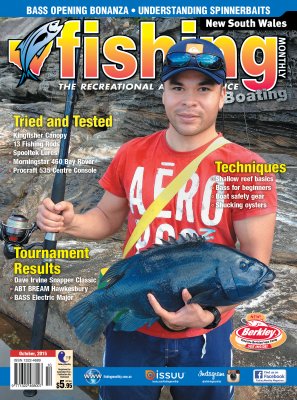Stalking the close reefs by Gary Earl
 We are a lucky bunch of anglers in this country. We have reefs and wrecks and undersea outcrops of rocks ranging from lone pinnacles to vast rocky stretches of bottom. Most of these features are so close to our shoreline that we can all get out to them in a reliable trailer boat, and we have a vast array of fishing technology to maximise our catch rates.
We are a lucky bunch of anglers in this country. We have reefs and wrecks and undersea outcrops of rocks ranging from lone pinnacles to vast rocky stretches of bottom. Most of these features are so close to our shoreline that we can all get out to them in a reliable trailer boat, and we have a vast array of fishing technology to maximise our catch rates.
With a sounder, GPS or just your computer, there's no reason why you can't find close offshore reefs in your area, no matter where you are on our coastline. One look on the Internet and you can pick your own area and see what kind of structure there is and the distances involved. Once you have a starting point, you can sound around to find fish-holding structure.
Fishing has come a long way from the old days of closing one eye and lining up that mountain to that tree and that island! I remember when the old mud map from a mate who trusted you was the only way to find a speculated reef or wreck. And once you were there it was still a guessing game as to where the structure actually was. You could be 10ft off the mark and catch nothing.
Now, however, you can get to a spot and fish with confidence as we have 3D sounders, wide views of reefs and every bottom type identified, whether it's gravel, rock, mud or sand. Over time, as you get confident with using your sounder, you may even be able to tell what species of fish are under the boat. I've fished with anglers who can consistently identify large mulloway, snapper or kingfish by the way they school over a reef. The way in which the fish react to the current, or how they sit on the structure being fished, is what tips these guys off. It shows the value of really learning how to use your sounder, and spending that extra time out on the water.
Once you have found your reef, wreck, pinnacle or gravel ground there are no hard and fast rules as to how you fish it. To give you a general guide, however, here's what has worked for me and other anglers at different times.
SPECIES
To write about every species that turns up on the reefs would be impossible, so I will concentrate on the main species targeted by most NSW reef fishers: snapper, mulloway, bream, tailor, morwong, trevally, teraglin, nannygai, squid and kingfish. They are the most often encountered species on the close reefs on the NSW coast.
Of course there are many more species you can encounter, depending on the water temperature and other factors. I have been on reefs off Port Stephens and seen spotted mackerel, Spanish mackerel, pearl perch and mangrove jacks, mixed in with the typical schools of fish. However, I have to admit the years in which this has happened have been few and far in between. Warm currents are the major factor in the captures of more northern species in any area.
Off the NSW coast you can encounter fish which are normally considered to be rock species - drummer and groper - throughout winter and spring. They hang over reefs around 2-5km offshore. Crabs, prawns and dough or bread can take both these species offshore, and it's best to fish for them the same way you would for snapper. A berley trail can entice fish very close to the back of your boat, and at times with bait circling in the trail you can see big predators come up as well. Kingfish and trevally are the two that seem to follow the baitfish all the way to the surface, and a rod with a lure loaded can be cast straight to them. Mahi mahi can also come in close to shore at times, and can end up in the trail. Sometimes it's the depth rather than the distance offshore that matters.
BAIT
The most popular way to fish the reefs is 'bottom bouncing' with a paternoster rig (typically two hooks spaced out above a snapper lead). It's how anglers have caught bottom-dwelling fish for the last 50 years.
When it comes to bait, obviously fresh is best, but that doesn't always mean you have to catch it yourself. At times the bait from your local servo, fish co-op or tackle shop can be really fresh and can work wonders, so don't discount it altogether. Check it out, assess the quality and buy some if it looks good.
Some anglers won't even think about fishing over reef without live bait, be it squid, yellowtail, yakkas, slimy mackerel, garfish, live pilchards, herring, small pike, or just legal whiting or tailor. Everyone has their own preference. I have found that if you start catching yellowtail, slimies, squid or garfish over a reef then you should use them as live bait. No matter what structure I'm fishing, I have caught most of my better fish by sourcing whatever baitfish or cephalopods I've found in the vicinity. They're what the predators are feeding on, so it makes sense to use these baits - or to imitate them with a soft plastic or chrome lure. If you use a lure that's the same size and colour as the bait the fish are feeding on, on most occasions you can't go wrong.